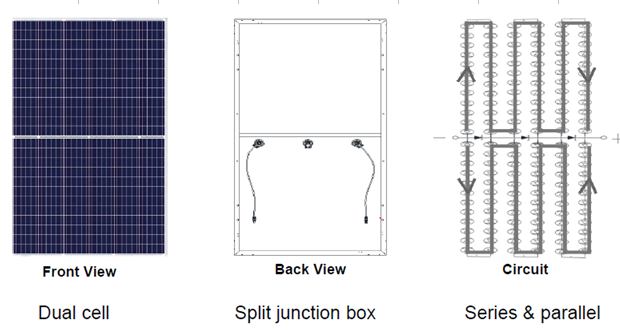|
<< Click to Display Table of Contents >> Twin half-cut cells and shadings |
  
|
|
<< Click to Display Table of Contents >> Twin half-cut cells and shadings |
  
|
Since some few years (2014), more and more manufacturers propose a new concept of PV modules arrangement named "Twin Half-cut cells" modules.
These modules involve half-cells strings, mounted in the following way:

Electrically, these modules are made of 2 sets of 3 strings of half-cells, mounted in parallel. Each pair of string shares the same by-pass diode.
In the PV modules definition (database), this should be defined as "Twin half-cells" layout, 60 (or 72) cells in series and 2 strings in parallel.
One of the main advantages waited from this configuration is an improvement in the mismatch under partial shadings. These modules behave as 2 half-modules mounted one above the other one. When the bottom half-module is shaded, the upper sub-module is still working, with half the current of the total module. This is the key point of the benefit of this configuration.
In a row arrangement, this is valid when the modules are disposed in portrait of course. For the landscape disposition, they will behave in the same way as usual modules.
In PVsyst, this situation may be taken into account in the calculation of the electrical shading losses.
Unlimited sheds
In the "Unlimited sheds" 2D calculation, where the electrical shading loss is considered complete as soon as the first bottom cell is shaded, we can simply consider loosing half the module instead of the full module width.
This means that we may define the number of strings as 2 times the real number of modules in the width of the row (i.e. define the height of the halt-module). However we have also to define the cell's size as half the size of a real cell (i.e. around 78 mm).
Electrical loss "according to strings of modules"
In this option we have to define a rectangle-string as the area covered by a full string.
In a row arrangement, if we have one only string of twin modules in portrait, we can define rectangles representing half-modules (i.e. normal divided by 2). The calculation will be correct.
However in any other situation, if we have 2 strings in a row (U-wiring), or the shades are not regular (BIPV), this option is not useable.
Module Layout
Since the version 7, the twin half-cut modules are fully implemented in the Module Layout construction. The Module Layout calculation is correct in any case.
See the "Shading 3D calculation" page for the details of the calculation of one module. In the array I/V construction, we will accumulate the I/V curves of each module, not sub-modules.
The manufacturer will claim several other advantages of this technology.
Busbars resistive loss
As the current in each string is divided by 2, the resistive loss in the busbars is divided by 4.
This gives an increase of some few percents to the STC power. The same module will pass to an upper power class. This is an advantage for the Manufacturer, as he will sell the STC power.
However under low-light conditions (@200 W/m2, the current is divided by 5, and the power loss by 25), there is no gain anymore. Therefore the relative low-light performance of the module is reduced. This is a disavantage for the customer.
Durability
As the cells are of smaller size, they are less fragile, an they are less sensitive to cracks.
Manufacturers affirm that the durability of such modules is improved.